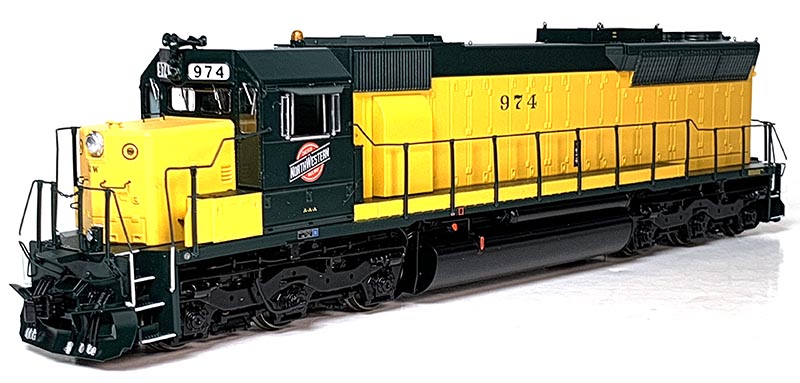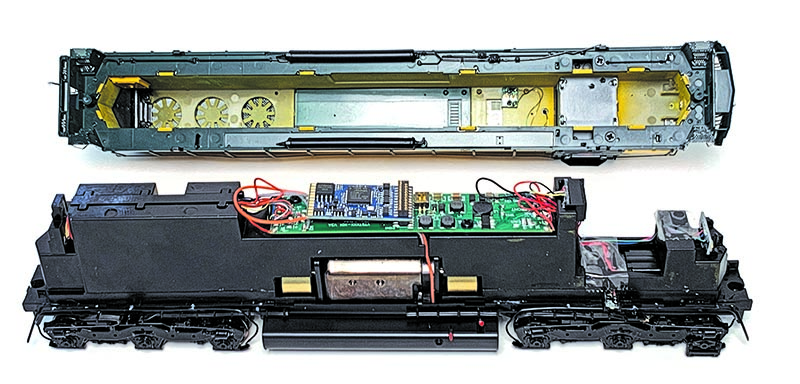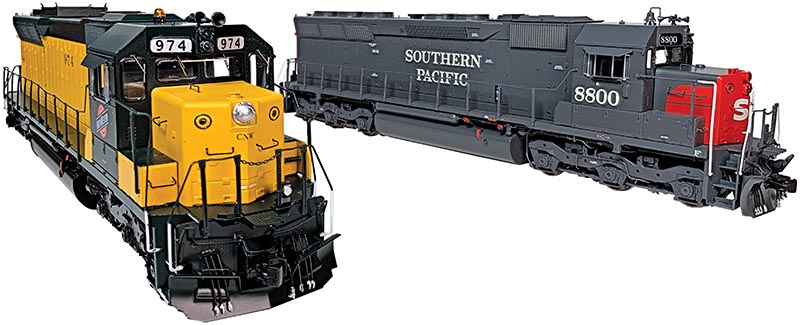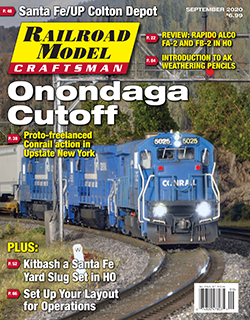 Review by Harry K. Wong/photos by the author
Review by Harry K. Wong/photos by the author
The decade of the 1960s marked an escalation of the “horsepower wars” between American locomotive manufacturers. Alco fielded increasingly powerful but fragile versions of its Century series locomotives to battle EMD GP20, SD24, GP30, and 35-series locomotives, while General Electric entered the domestic locomotive market with its 2,500-horsepower U25B and U25C diesels with notable success.
At EMD, it became apparent that the electrical and physical limits of its 567-based 35-series locomotives were being reached, yet the railroads of the period demanded more horsepower to pull the high-priority piggyback and expedited freight deemed necessary to compete with competition from trucks on the highway. Dissatisfied with domestic offerings, Western railroads such as Southern Pacific and Denver & Rio Grande Western experimented with 4,000-horsepower diesel-hydraulic units from Germany to address their needs, while Union Pacific took to giant double-diesels and gas turbines to speed main line freight across its system.

Facing the challenge, 645-series prime mover development quietly began at EMD, first manifesting itself on the rails within a group of mysterious-looking test locomotives, all but one painted in solid black. These pre-production testbeds — EMD 433A, 434, and 434A-434H — barnstormed the main lines of North America beginning in July 1964. With an extra 78 cubic inches of displacement per cylinder over its famed predecessor, the new 645 design beget a family of prime movers in 8-, 12-, 16-, and for the first time, a 20-cylinder turbocharged configuration. These units were also fitted with an all-new AR10 alternator and an upgraded electrical system that promised greater reliability.
Unlike its lesser brethren, the SD45 was the first EMD locomotive to reach series production with a flared radiator section. The flared radiators provided room for the increased cooling capacity necessary for its massive 20-cylinder prime mover. As the crown of EMD’s 1966 product line, the SD45 finally delivered the oomph long sought by American railroads. An instant hit, 1,260 SD45s were produced for nearly all major Class I railroads in the U.S.
ScaleTrains.com has just released its first production of EMD’s iconic SD45 locomotive in HO scale in its entry-level “Operator series” with generic detail and one for its premium “Rivet Counter” line. As is customary of its Rivet Counter line of products, the ScaleTrains SD45 is offered in multiple versions, with details and lettering specific not just to each railroad, but to each road number for each railroad representing specific time periods and delivery groups. The models offered in this release replicate units from bespoke orders of SD45s from Southern Pacific, Pennsylvania, Seaboard Coast Line, and Chicago & North Western. Together, they represent a cross-section of disparate units across the entire production period of SD45s from December 1965 through October 1971. We received Rivet Counter versions of the Southern Pacific and Chicago & North Western SD45s for this review.

Exceptional Detail
Never produced before in plastic in any scale until now is the unique non-dynamic brake-equipped version of the SD45 owned only by the Chicago & North Western. The C&NW models in this release represent the railroad’s second order of SD45s. This group was made up of 41 units numbered 937–977, and was delivered in January and February 1969. Road-specific features include a nose-mounted gong bell; a Federal Signal 372 rotary beacon; and a flat, unadorned hood section (instead of dynamic brake grids with cooling fans) above the prime mover section, unlike SD45s of all other roads.
Later-style Flexicoil-C trucks with high-mounted brake cylinders, a zigzag-style pilot face and early “X” pattern tread plate are amongst the very long list of notable details for this C&NW version. The FRA-mandated “loop handle”-style coupler lift bars on each pilot appeared around 1978 on these engines. Thus the modeling period for the C&NW SD45s in this release date from 1978 onward through the 1980s until their retirement in the early 1990s.
The Southern Pacific SD45s in this ScaleTrains release depict the first order of 45 units delivered as SP 8800–8844, as they appeared in the 1970s. These first SP SD45s arrived on the railroad in August and September 1966. This first group possesses a number of unique characteristics not repeated on subsequent orders to the SP. These idiosyncrasies include a ratchet-style handbrake in the 81” nose, resulting in a different hood door arrangement under the radiator section lacking the brake wheel cutout at the far end of the long hood. On the cab, an extended-vision engineer’s windshield includes an extra-thin window post instead of a continuous L-window. Dual fuel fillers are both mounted forward of the air reservoirs on each side, also different from subsequent orders of SD45s for SP (and subsidiary Cotton Belt). The Flexicoil-C truck side frames for this SP version sport low-mounted brake cylinders between each axle, correct for SP 8800–8844 as delivered from EMD. All of these features are accurately captured in scale.

As the Southern Pacific version in this release depicts units in the prime of their service life, additional dynamic brake vents are visible upon the dynamic brake compartment while a full complement of illuminated Pyle Gyralites with simulated oscillation effects are retained on the front end of the locomotive. A dual clear Gyralite housing is located between the number boards, while a single Pyle 17540 oval Gyralite housing with a red LED is mounted in the nose above the dual sealed beam Pyle headlight. Prenumbered SP units in this release come with the signature 21” sans-serif block “SP” on the nose that began appearing on SP road locomotives in 1971. Unnumbered SP units are also available that lack any nose lettering or nose numbers, allowing modelers to also depict 8800s with the as-delivered 5-inch-tall road numbers located on the nose. Early as-delivered photos of prototype SP SD45s in this class show a smaller pilot plow, but those plows were quickly replaced by a taller and wider snowplow shortly after delivery as depicted in this production run for the SP models. Atop the cab roof, modelers will find era appropriate details for these SP units, including a Nathan P3 air horn, bell, and whip antenna base.
Though there have been many renditions of HO scale SD45s in the past, none have achieved the level of fidelity to the prototype as the ScaleTrains.com model, especially in terms of accurately capturing the phase and production differences that occurred between the first SD45 in 1965 and the final one to roll out of La Grange, Ill., in December 1971. Going well beyond just long- and short-traction motor ducts and differing locations of brake appliances on the truck side frames, once-minute differences such as straight versus drop-down-style grab irons, and tab versus zigzag-style pilot faces with high or low stepwells and much more are now replicated in scale to match specific prototypes with the ScaleTrains model…




